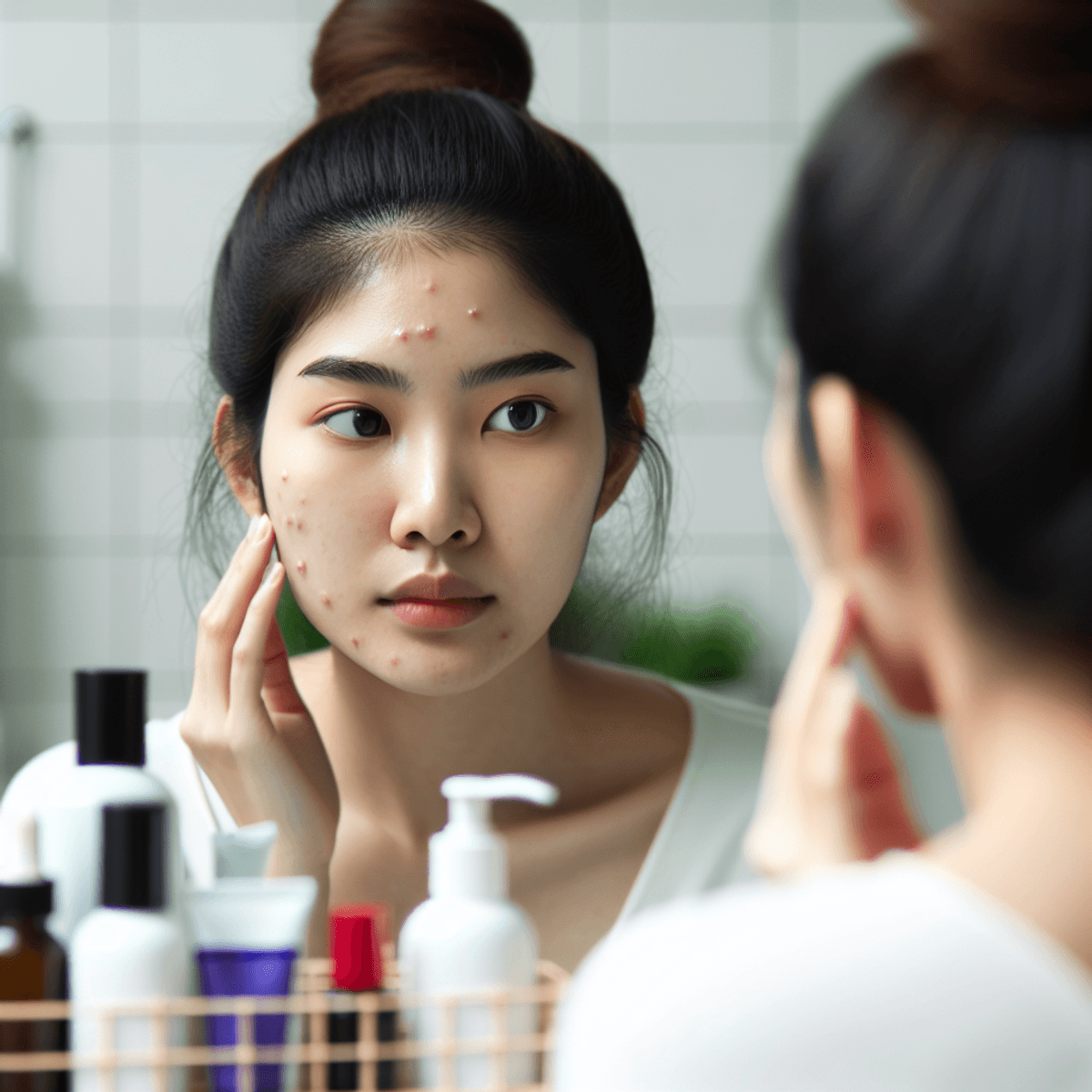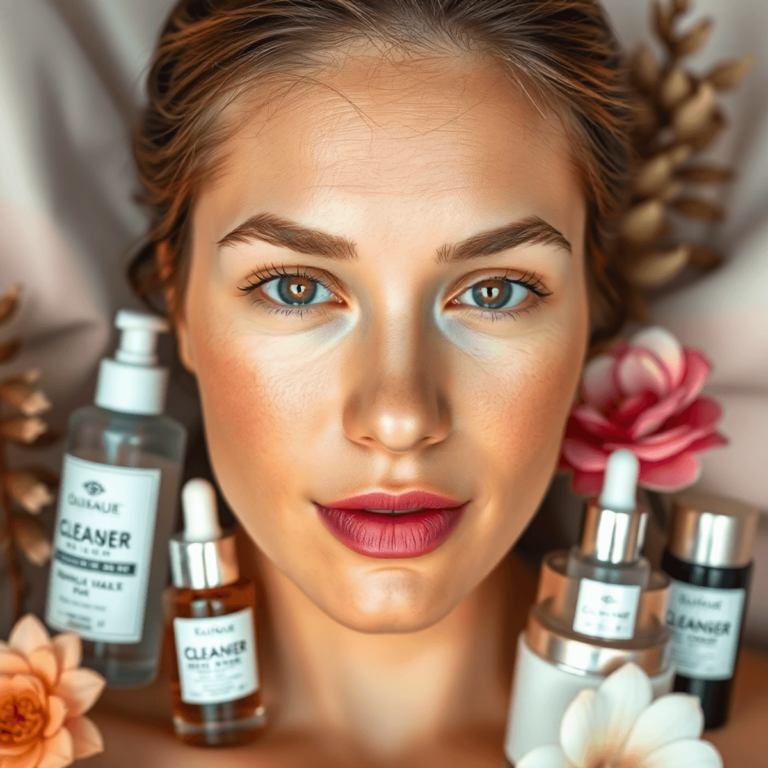9 things to try when acne won’t clear

Understanding Persistent Acne
Many people struggle with persistent acne, which can be frustrating and make them self-conscious. This condition usually involves breakouts that last longer than expected and don’t respond well to over-the-counter treatments.
Why It’s Challenging to Treat
There are a few reasons why stubborn acne can be difficult to treat:
- Multiple Causes: Hormonal changes, genetics, and lifestyle factors all play a role in stubborn acne.
- Skin Sensitivity: Using too many treatments on the skin can cause irritation, making it harder to find effective solutions.
Strategies for Managing Stubborn Acne
To effectively address stubborn acne, it’s important to take a comprehensive approach. Here are some strategies that may help:
- Adopt a consistent skincare routine
- Explore different treatment methods
- Seek guidance from skincare professionals for personalized advice
The Importance of Patience
Patience is key when dealing with persistent acne. Treatments may take time to show results, and it’s often necessary to combine different approaches tailored to your specific needs.
Working Towards Healthier Skin
While achieving clearer skin may take time, there are effective strategies you can use to help clear stubborn breakouts. By understanding the underlying causes of your acne and implementing these strategies, you can work towards healthier skin.
1. Give Treatments Time
Patience is key when it comes to acne treatment. Understanding the timeline for effectiveness can make a significant difference in your approach.
Here’s what you can expect:
- Initial Results: Many treatments require a consistent application of at least 4 to 6 weeks before you start noticing any improvements.
- Long-Term Improvements: Significant changes, such as clearer skin, typically become apparent after about 2 to 3 months of dedicated use.
This duration is crucial because your skin needs time to respond and heal. Acne treatments work by gradually unclogging pores, reducing inflammation, and eliminating bacteria. Rapid changes in your skincare routine or frequent switching between products can hinder progress.
Be diligent in your regimen. Applying treatments consistently helps maintain momentum toward clearer skin. Tracking changes over time can also provide motivation. Consider keeping a journal or taking photos every few weeks to observe improvements.
Remember, the journey to clear skin may be slow, but with patience and consistency, you can achieve desired results while minimizing frustration along the way.
2. Use Multiple Approaches
Dealing with stubborn acne often requires a combination of different methods. Each case of acne can vary greatly, influenced by factors such as hormones, bacteria, and excess oil production. By using multiple treatment options, you can effectively target these various causes.
Benzoyl Peroxide
One of the most popular ingredients in acne treatment is benzoyl peroxide. This powerful compound works primarily by reducing the presence of acne-causing bacteria on the skin. Here’s how it functions:
- Bacteria Reduction: Benzoyl peroxide penetrates the skin and releases oxygen into the pores. This oxygen is lethal to Propionibacterium acnes, the bacteria responsible for acne development, thereby reducing inflammation and preventing new breakouts.
- Keratinocyte Regulation: It also aids in regulating the turnover of skin cells, preventing them from clogging pores and leading to acne.
Recommended Usage and Concentrations:
- Start with a lower concentration (2.5% or 5%) if you have sensitive skin to minimize irritation.
- Gradually increase to 10% if needed, based on tolerance and effectiveness.
- Apply a thin layer once daily at first; you can increase frequency to twice daily as your skin adjusts.
- Ensure that your skin is clean and dry before application for optimal absorption.
Incorporating benzoyl peroxide into your skincare routine can be highly effective when paired with other products targeting different aspects of acne. For example:
Retinoids
Retinoids are another cornerstone in acne treatment. They work by promoting cell turnover, reducing oiliness, and preventing clogged pores. These treatments come in various forms:
- Topical retinoids such as tretinoin or adapalene are commonly prescribed for their efficacy in treating acne.
Salicylic Acid
Salicylic acid is known for its ability to penetrate deep into the pores and exfoliate from within:
- It helps reduce inflammation and clears out dead skin cells that might block pores.
Using a combination of these treatments can provide comprehensive care for stubborn acne:
- Benzoyl peroxide targets bacteria,
- Retinoids prevent clogged pores,
- Salicylic acid reduces inflammation.
Approaching your skincare regimen with a blend of these active ingredients enhances overall efficacy. Each component addresses specific underlying issues contributing to your breakouts, increasing the likelihood of clearer skin over time.
Additionally, it’s important to note that while these treatments can be very effective, they may also come with side effects such as dryness or irritation[^1^]. Therefore, it’s advisable to consult with a healthcare professional before starting any new treatment regimen[^2^].
Retinoids
Retinoids are essential in fighting acne by stopping pores from getting clogged and reducing oiliness. These compounds, which come from vitamin A, encourage the skin to shed its old cells and create new ones. This process helps treat various causes of acne, such as too much oil production and the buildup of dead skin cells.
Benefits of Retinoids:
- Prevention of Clogged Pores: By encouraging rapid cell turnover, retinoids help keep pores clear, reducing the likelihood of breakouts.
- Oil Reduction: These compounds also regulate sebum production, addressing one of the primary contributors to acne.
Types of Retinoids Available:
- Tretinoin: Often prescribed for moderate to severe acne, it’s a potent option that effectively manages stubborn breakouts.
- Adapalene: Available over-the-counter, adapalene is milder but still provides significant benefits for acne-prone skin.
- Tazarotene: This prescription-strength retinoid targets severe cases and can be particularly effective for inflammatory acne.
Using retinoids along with other treatments like benzoyl peroxide and salicylic acid can greatly improve results. This combination approach tackles different causes of acne, offering a comprehensive solution by targeting bacteria reduction, unclogging pores, and calming inflammation.
Salicylic Acid
Salicylic acid is a powerful ingredient used to treat acne. It works by reducing inflammation and promoting exfoliation. Here’s how it helps:
1. Reduces Inflammation
Salicylic acid effectively calms redness and swelling associated with breakouts, making it ideal for those experiencing painful or inflamed acne.
2. Exfoliates the Skin
This beta hydroxy acid penetrates deep into the pores, helping to dissolve excess sebum and dead skin cells. By preventing clogged pores, salicylic acid addresses one of the primary causes of acne.
3. Combination Treatments
Incorporating salicylic acid with other products like benzoyl peroxide and retinoids enhances overall effectiveness. While benzoyl peroxide focuses on bacteria reduction, salicylic acid manages inflammation, creating a comprehensive approach to treating various acne causes.
Proper Application Tips
- Use a salicylic acid product as part of your daily skincare routine. Start with a lower concentration (0.5% to 2%) to assess skin tolerance.
- Apply a thin layer directly onto affected areas after cleansing, avoiding sensitive areas such as around the eyes.
- Gradually increase frequency as your skin adjusts. Consider using it every other day initially, then daily if your skin responds well.
With consistent use and proper application, salicylic acid can significantly contribute to achieving clearer skin.
3. Follow Directions
Adherence to skincare instructions is crucial for achieving desired results in acne treatment. Following your dermatologist’s guidance on product usage can significantly influence the effectiveness of your regimen. Consider these key points:
- Frequency: Products should be applied as directed, whether it’s daily, weekly, or bi-weekly. Skipping applications or using them too infrequently can hinder improvement.
- Duration: Allow treatments to remain on the skin for the recommended time. Rinse-off products often need a specific duration for optimal results.
- Layering Products: Understanding how to layer products ensures each one works effectively without causing irritation. Always follow directions regarding which products can be combined and in what order.
Following these guidelines allows you to maximize the benefits of your treatment plan. Proper product usage not only helps target stubborn acne but also promotes overall skin health, paving the way for clearer skin over time.
4. Proper Skin Care Routine
Establishing a daily skincare routine tailored for acne-prone skin is crucial for achieving clearer skin. Here are the essential components to consider:
- Gentle Cleansing: Use a mild, non-comedogenic cleanser twice daily—once in the morning and once at night. Avoid harsh scrubs or cleansers that can irritate the skin and worsen breakouts.
- Lightweight Moisturizers: Opt for oil-free, non-comedogenic moisturizers. These products provide hydration without clogging pores, which is vital for maintaining skin balance.
- Sunscreen Protection: Incorporate a broad-spectrum sunscreen with an SPF of at least 30 into your morning routine. Select a formula that is non-comedogenic to prevent additional breakouts from sun exposure.
- Exfoliation: Include gentle exfoliation in your routine 1-2 times per week using products with salicylic acid or glycolic acid. This helps remove dead skin cells and prevents clogged pores without causing irritation.
- Spot Treatments: For active breakouts, apply targeted treatments containing benzoyl peroxide or salicylic acid directly to blemishes as needed. Ensure these are used sparingly to avoid excessive dryness.
Maintaining consistency in your skincare regimen promotes gradual improvement in skin texture and clarity. Each product should be chosen carefully, prioritizing formulations that cater specifically to acne-prone skin needs. By adhering to these guidelines, you can effectively manage persistent acne while promoting healthier skin overall.
5. Avoid Popping Pimples
Popping pimples may seem like a quick solution, but it can actually make things worse. This habit often leads to:
- Worsening of acne: Squeezing a pimple can push bacteria and pus deeper into the skin, resulting in more inflammation and potentially new breakouts.
- Scarring risks: Damage to the skin can cause permanent scars, making it vital to resist the urge to pop.
- Infection: Opening a pimple exposes your skin to bacteria, increasing the chance of infection.
Instead of popping pimples, try these alternative methods for managing active breakouts:
- Spot treatments: Use products containing benzoyl peroxide or salicylic acid directly on the pimple. These ingredients work effectively for reducing size and inflammation.
- Ice method: Applying a cold compress can help reduce swelling and redness quickly, offering relief from painful spots.
- Natural remedies: Options like tea tree oil or aloe vera gel can soothe irritated skin and promote healing.
By implementing these practices instead of popping, you can achieve healthier skin outcomes.
6. Consistent Application Across Breakout-Prone Areas
Applying acne medication consistently across all breakout-prone areas is crucial for effective treatment. Focusing solely on individual blemishes can lead to uneven results and missed opportunities for prevention. Here are key points to consider:
- Comprehensive Coverage: Acne often appears in clusters or patterns. Treating only visible spots neglects the surrounding skin where new breakouts may form.
- Prevention of Future Breakouts: By applying medication to the entire area, you reduce the likelihood of future pimples developing. This proactive approach addresses potential issues before they become noticeable.
- Types of Products: Utilize a thin layer of appropriate products such as benzoyl peroxide or retinoids on affected zones. Ensure even distribution to maximize effectiveness.
- Consistency is Key: Adhere to a regular routine, applying treatments daily as recommended by your dermatologist. Skipping applications can hinder progress, allowing bacteria and oil to build up.
- Patience Pays Off: Expect gradual improvement over time. A consistent approach will yield better long-term results compared to sporadic spot treatments.
Applying medications broadly across breakout-prone areas ensures you tackle acne effectively while promoting healthier skin overall.
7. Maintain Clean Bedding Hygiene
Clean bedding hygiene is essential for reducing bacteria on the skin, which can contribute to acne. Regularly changing your bedding helps create a healthier environment for your skin. Here are some tips to maintain optimal cleanliness:
- Change Pillowcases Weekly: Your pillowcase collects oils, sweat, and bacteria from your skin and hair. Frequent changes can minimize these irritants.
- Wash Sheets Regularly: Aim to wash your sheets every one to two weeks. Use hot water (at least 130°F or 54°C) to kill any lingering bacteria that could lead to breakouts.
- Select Appropriate Detergents: Choose fragrance-free and hypoallergenic detergents to avoid irritation. These products reduce the risk of allergic reactions that may exacerbate skin conditions.
- Consider Using Mattress Protectors: A protective cover can make cleaning easier and create an additional barrier against allergens and bacteria.
- Maintain Clean Sleep Environment: Dust mites and other allergens can thrive in unclean bedding. Keep your bedroom tidy, dust regularly, and vacuum carpets frequently.
By maintaining clean bedding hygiene, you create a more favorable environment for your skin’s health. This practice complements other skincare routines in achieving clearer skin.
8. Consult a Dermatologist When Necessary
Persistent acne can sometimes indicate underlying issues that require professional intervention. Recognizing when to seek professional advice for severe cases like cystic acne is crucial. Cystic acne is characterized by painful, deep, and inflamed breakouts that often do not respond to standard over-the-counter treatments.
Signs You Should See a Dermatologist
- Severe Pain: If your acne causes significant discomfort or pain.
- Scarring: Noticeable scars or marks from previous breakouts.
- Ineffective Over-the-Counter Treatments: No improvement after consistent use of topical products.
- Recurring Breakouts: Frequent and persistent breakouts in the same areas.
Recommended Treatments
A dermatologist may offer various treatment options tailored to the severity of your acne:
- Oral Medications: Antibiotics or hormonal treatments can target the root causes, reducing inflammation and bacteria.
- Topical Retinoids: Stronger formulations may be prescribed to help unclog pores and promote skin cell turnover.
- Laser Therapy: Advanced techniques like laser treatments can reduce inflammation and scarring effectively.
Consulting a dermatologist ensures you receive an accurate diagnosis and appropriate treatment plan tailored to your specific needs. This proactive approach can lead to clearer skin and improved confidence.
9. Consider Lifestyle Factors That Can Affect Your Skin’s Condition Too!
Lifestyle impacts on overall skin health beyond just topical treatments alone. Evaluating personal habits can reveal underlying contributors to persistent breakouts, dryness, or sensitivity. Here are some key areas to consider:
Diet
- Avoid excessive dairy and sugar. Studies suggest that high glycemic index foods can trigger acne flare-ups.
- Incorporate a balanced diet rich in fruits, vegetables, whole grains, and lean proteins to support skin health.
Stress Management
- High stress levels can lead to hormonal fluctuations that worsen acne. Regular exercise can help alleviate stress.
- Meditation and mindfulness practices promote relaxation, which can positively affect your skin.
Sleep Quality
- Aim for 7-9 hours of quality sleep each night. Poor sleep can lead to increased inflammation and exacerbate skin issues.
- Establish a calming bedtime routine to enhance sleep hygiene.
Maintaining good skincare practices is essential; however, lifestyle choices play a crucial role in achieving clear skin. Addressing these factors not only helps manage acne but also promotes overall well-being. By implementing these changes consistently, you may notice improvements in your skin’s condition.
Consider integrating these lifestyle adjustments into your daily routine for a holistic approach to skincare. Your journey towards clearer skin may benefit significantly from focusing on both topical treatments and healthy living habits.










